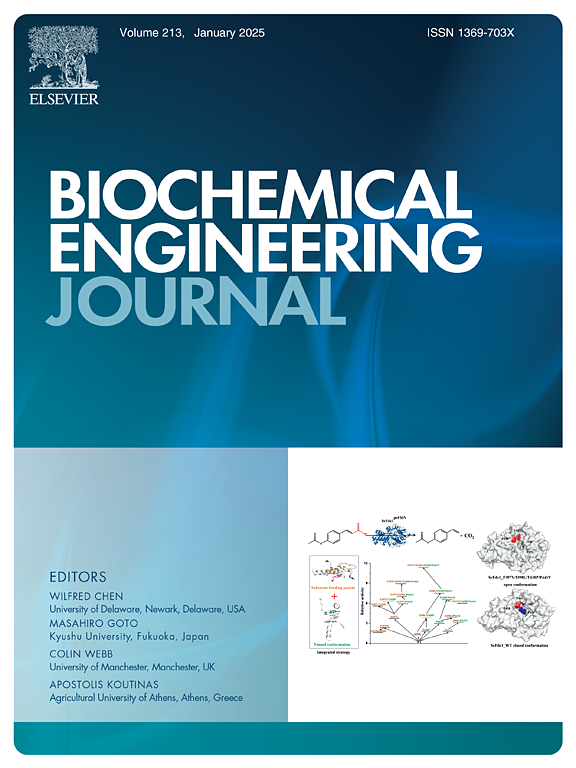Rerouting of phytosterol degradation pathways in targeted high-yield and high-purity 9α-hydroxyandrost-4-ene-3,17-dione microbial biotransformation
IF 3.7
3区 生物学
Q2 BIOTECHNOLOGY & APPLIED MICROBIOLOGY
引用次数: 0
Abstract
9α-Hydroxyandrost-4-ene-3,17-dione (9-OHAD) is a representative precursor in steroid drug synthesis. However, during the 9-OHAD production from phytosterol in Mycolicibacterium neoaurum (M. neoaurum), the current manufacturing processes suffer from low productivity and purity due to the generation of a variety of by-products. In this study, we genetically modified the phytosterol catabolism in M. neoaurum and achieved 13.4 g/L and 91.1 % molar yield of 9-OHAD with no detectable by-products at a high phytosterol concentration of 20 g/L in shake flask. It was achieved by inactivating Opccr, SalA, TeB, and overexpressing KshA1 and ChsH1–2 to eliminate the production of 20-hydroxymethyl-9,21-dihydroxy-20-methyl-pregna-4-en-3-one (9-OH-4-HBC), 4-androstene-3,17-dione (4-AD) and 3-oxo-4-pregnene-9-OH-20-carboxylic methyl ester (9-OH-3-OPCM) as well as overcoming the production limitations of 9-OHAD. Notably, when scaled up in a 5 L bioreactor with 45 g/L phytosterol concentration, the modified M. neoaurum achieved 24.5 g/L and 74.5 % molar conversion of 9-OHAD by using soybean oil and (2-hydroxypropyl)-β-cyclodextrin (HP-β-CD) as a co-solvent and antifoam agent. Therefore, our findings demonstrate a method to improve the efficiency and purity of 9-OHAD biosynthesis in M. neoaurum.
高产高纯9α-羟基雄激素-4-烯-3,17-二酮微生物转化中植物甾醇降解途径的重新定位
9α-羟基雄激素-4-烯-3,17-二酮(9-OHAD)是类固醇药物合成中具有代表性的前体。然而,在新aurum分枝杆菌(M. neoaurum)中从植物甾醇生产9-OHAD的过程中,由于产生各种副产物,目前的生产工艺存在生产率和纯度低的问题。在本研究中,我们对新aurum的植物甾醇分解代谢进行了基因改造,在摇瓶中植物甾醇浓度为20 g/L时,9-OHAD的摩尔产率为13.4 g/L和91.1 %,无检测到副产物。通过灭活Opccr、SalA、TeB,过表达KshA1和ChsH1-2,消除了20-羟基甲基-9、21-二羟基-20-甲基-孕烯-4-烯-3-酮(9-OH-4-HBC)、4-雄烯-3、17-二酮(4-AD)和3-氧-4-孕烯-9- oh -20-羧基甲酯(9-OH-3-OPCM)的产生,克服了9-OHAD的生产限制。值得注意的是,在5 L的生物反应器中,当植物甾醇浓度为45 g/L时,使用豆油和(2-羟丙基)-β-环糊精(HP-β-CD)作为助溶剂和消泡剂,改性后的M. neoaurum的9-OHAD的摩尔转化率分别为24.5 g/L和74.5 %。因此,我们的研究结果为提高新金分枝杆菌9-OHAD的生物合成效率和纯度提供了一种方法。
本文章由计算机程序翻译,如有差异,请以英文原文为准。
求助全文
约1分钟内获得全文
求助全文
来源期刊

Biochemical Engineering Journal
工程技术-工程:化工
CiteScore
7.10
自引率
5.10%
发文量
380
审稿时长
34 days
期刊介绍:
The Biochemical Engineering Journal aims to promote progress in the crucial chemical engineering aspects of the development of biological processes associated with everything from raw materials preparation to product recovery relevant to industries as diverse as medical/healthcare, industrial biotechnology, and environmental biotechnology.
The Journal welcomes full length original research papers, short communications, and review papers* in the following research fields:
Biocatalysis (enzyme or microbial) and biotransformations, including immobilized biocatalyst preparation and kinetics
Biosensors and Biodevices including biofabrication and novel fuel cell development
Bioseparations including scale-up and protein refolding/renaturation
Environmental Bioengineering including bioconversion, bioremediation, and microbial fuel cells
Bioreactor Systems including characterization, optimization and scale-up
Bioresources and Biorefinery Engineering including biomass conversion, biofuels, bioenergy, and optimization
Industrial Biotechnology including specialty chemicals, platform chemicals and neutraceuticals
Biomaterials and Tissue Engineering including bioartificial organs, cell encapsulation, and controlled release
Cell Culture Engineering (plant, animal or insect cells) including viral vectors, monoclonal antibodies, recombinant proteins, vaccines, and secondary metabolites
Cell Therapies and Stem Cells including pluripotent, mesenchymal and hematopoietic stem cells; immunotherapies; tissue-specific differentiation; and cryopreservation
Metabolic Engineering, Systems and Synthetic Biology including OMICS, bioinformatics, in silico biology, and metabolic flux analysis
Protein Engineering including enzyme engineering and directed evolution.
 求助内容:
求助内容: 应助结果提醒方式:
应助结果提醒方式:


